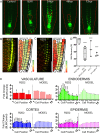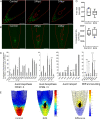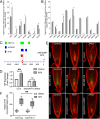Rocks in the auxin stream: Wound-induced auxin accumulation and ERF115 expression synergistically drive stem cell regeneration
- PMID: 32601177
- PMCID: PMC7368246
- DOI: 10.1073/pnas.2006620117
Rocks in the auxin stream: Wound-induced auxin accumulation and ERF115 expression synergistically drive stem cell regeneration
Erratum in
-
Correction for Canher et al., Rocks in the auxin stream: Wound-induced auxin accumulation and ERF115 expression synergistically drive stem cell regeneration.Proc Natl Acad Sci U S A. 2021 Jul 27;118(30):e2111311118. doi: 10.1073/pnas.2111311118. Proc Natl Acad Sci U S A. 2021. PMID: 34282025 Free PMC article. No abstract available.
Abstract
Plants are known for their outstanding capacity to recover from various wounds and injuries. However, it remains largely unknown how plants sense diverse forms of injury and canalize existing developmental processes into the execution of a correct regenerative response. Auxin, a cardinal plant hormone with morphogen-like properties, has been previously implicated in the recovery from diverse types of wounding and organ loss. Here, through a combination of cellular imaging and in silico modeling, we demonstrate that vascular stem cell death obstructs the polar auxin flux, much alike rocks in a stream, and causes it to accumulate in the endodermis. This in turn grants the endodermal cells the capacity to undergo periclinal cell division to repopulate the vascular stem cell pool. Replenishment of the vasculature by the endodermis depends on the transcription factor ERF115, a wound-inducible regulator of stem cell division. Although not the primary inducer, auxin is required to maintain ERF115 expression. Conversely, ERF115 sensitizes cells to auxin by activating ARF5/MONOPTEROS, an auxin-responsive transcription factor involved in the global auxin response, tissue patterning, and organ formation. Together, the wound-induced auxin accumulation and ERF115 expression grant the endodermal cells stem cell activity. Our work provides a mechanistic model for wound-induced stem cell regeneration in which ERF115 acts as a wound-inducible stem cell organizer that interprets wound-induced auxin maxima.
Keywords: Arabidopsis; ERF115; auxin; regeneration; stem cells.
Conflict of interest statement
The authors declare no competing interest.
Figures






References
-
- Aichinger E., Kornet N., Friedrich T., Laux T., Plant stem cell niches. Annu. Rev. Plant Biol. 63, 615–636 (2012). - PubMed
-
- Pi L. et al. ., Organizer-derived WOX5 signal maintains root columella stem cells through chromatin-mediated repression of CDF4 expression. Dev. Cell 33, 576–588 (2015). - PubMed
-
- Bennett T., Scheres B., Root development—two meristems for the price of one? Curr. Top. Dev. Biol. 91, 67–102 (2010). - PubMed
-
- Ha C. M., Jun J. H., Fletcher J. C., Shoot apical meristem form and function. Curr. Top. Dev. Biol. 91, 103–140 (2010). - PubMed
Publication types
MeSH terms
Substances
LinkOut - more resources
Full Text Sources
Molecular Biology Databases

